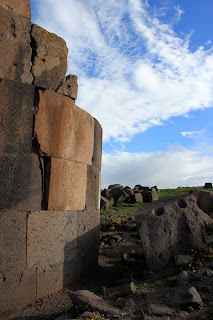Many of the knitting ladies are from the department -- Peru's equivalent of a state -- of Puno, and I finally made it to the capital city (also called Puno) and Lake Titicaca on the southeastern border of Peru the final weekend of March. Early that Saturday morning, Alex and I packed all of our warmest clothes and boarded a bus for the six-hour ride from Arequipa. When we arrived in Puno late that morning, we were greeted by this lovely view of the city extending up from the shores of the lake to the hills that surround it:
I was actually a little surprised by how beautiful the city was because I had heard some negative reviews of Puno over the years from visitors. The ladies always insisted it was because of lack of preparation for the cold (most visit in June and July, the dead of winter here) and altitude, and I think they might be right.
In addition to the chilly nights, the city sits at 12,421 feet, which is a good 7,000 + feet higher than Denver, enough to potentially leave you feeling the effects of altitude sickness if you're not acclimated. I'd already been in Arequipa for about two months at this point so it didn't bother me, but visitors coming from sea level beware: Pack accordingly and try to ease your way up to the altitude by starting with a stepping stone like Arequipa if you can.
First things first, we headed down to the shores of Lake Titicaca so Alex could try the city's famous fresh-caught trout. He somehow managed to down this fish and accompanying french fries (typical in Peru, the Land of Potatoes) in the ten minutes we had for lunch before it was time to meet our tour bus. He wasn't disappointed.
After our quick lunch, we made our way back up the hill and boarded a tour bus that took us to Sillustani, pre-Incan ruins and terraces (below) about 45 minutes outside of town.
Built to house their mummified dead, the burial towers, or chullpas, were most likely constructed by the Colla, an Aymara-speaking group, in the 1400s before they were conquered by the Incas. Many of the towers were left unfinished, and others have fallen into disrepair. Still, you could see the amazing work that has made many call these structures superior to the work of the Incas.
A little background on Aymara: Though it's the mother tongue of fewer than 2% of Peruvians (a number which continues to drop each year), Aymara is still the second most common indigenous language spoken in Peru. The majority of the world's two million speakers live in Bolivia, but many also live in Puno and in northern Chile. While most of the women in the workshop speak Quechua, the language used by the Incas, as their first language, Valvina and a few others from the Puno area are Aymara speakers, and it's a very important part of their culture.
The chullpas were interesting, but as we continued up the hill and the sun began to lower in the sky, we started to get a little distracted by the gorgeous sky and green landscape...
The view from the top of the hill as we looked down on Lake Umayo was probably the highlight of the day. I had a hard time getting on the tour bus and leaving the breathtaking views and fresh air behind, but the sun was setting quickly and it was starting to get chilly.
On our way back to town, we stopped by a home that was open to tourists so we could see how people live in the area. I'm generally a little uncomfortable with these home invasions, but I couldn't pass up a photo of this cuy bungalow. Just tell me those little guys aren't happy.
Another gorgeous sky on our bus ride into town:
Back in town, we found a pizzeria recommended by a friend of Alex's from the area (El Buho) and warmed up over dinner. Thinking we'd check out Puno's night life, we stopped into a club up the road. Dancing didn't last long, though, and soon heavy eyes, cold fingers, clumsy hiking boots and the knowledge that another early morning was in store won out and we headed home the for the night...












2 comments:
Hooray--an update! The photos are absolutely gorgeous. So glad you were able to do this trip--I know you've talked about going for ages. Miss you!
Hooray -- you're alive! I'd hoped to get the second day's entry up right away, but my laptop had a little run-in with some tea so there's been a delay. Soon, though... Miss you, too!
Post a Comment